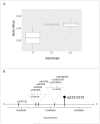Epigenetic contribution of the myosin light chain kinase gene to the risk for acute respiratory distress syndrome
- PMID: 27543902
- PMCID: PMC5253100
- DOI: 10.1016/j.trsl.2016.07.020
Epigenetic contribution of the myosin light chain kinase gene to the risk for acute respiratory distress syndrome
Abstract
Acute respiratory distress syndrome (ARDS) is a devastating clinical syndrome with a considerable case fatality rate (∼30%-40%). Health disparities exist with African descent (AD) subjects exhibiting greater mortality than European descent (ED) individuals. Myosin light chain kinase is encoded by MYLK, whose genetic variants are implicated in ARDS pathogenesis and may influence ARDS mortality. As baseline population-specific epigenetic changes, that is, cytosine modifications, have been observed between AD and ED individuals, epigenetic variations in MYLK may provide insights into ARDS disparities. We compared methylation levels of MYLK cytosine-guanine dinucleotides (CpGs) between ARDS patients and intensive care unit (ICU) controls overall and by ethnicity in a nested case-control study of 39 ARDS cases and 75 non-ARDS ICU controls. Two MYLK CpG sites (cg03892735 and cg23344121) were differentially modified between ARDS subjects and controls (P < 0.05; q < 0.25) in a logistic regression model, where no effect modification by ethnicity or age was found. One CpG site was associated with ARDS in patients aged <58 years, cg19611163 (intron 19, 20). Two CpG sites were associated with ARDS in EDs only, gene body CpG (cg01894985, intron 2, 3) and CpG (cg16212219, intron 31, 32), with higher modification levels exhibited in ARDS subjects than controls. Cis-acting modified cytosine quantitative trait loci (mQTL) were identified using linear regression between local genetic variants and modification levels for 2 ARDS-associated CpGs (cg23344121 and cg16212219). In summary, these ARDS-associated MYLK CpGs with effect modification by ethnicity and local mQTL suggest that MYLK epigenetic variation and local genetic background may contribute to health disparities observed in ARDS.
Copyright © 2016 Elsevier Inc. All rights reserved.
Figures



Similar articles
-
Genetic and epigenetic regulation of the non-muscle myosin light chain kinase isoform by lung inflammatory factors and mechanical stress.Clin Sci (Lond). 2021 Apr 16;135(7):963-977. doi: 10.1042/CS20201448. Clin Sci (Lond). 2021. PMID: 33792658 Free PMC article.
-
Variation in the myosin light chain kinase gene is associated with development of acute lung injury after major trauma.Crit Care Med. 2008 Oct;36(10):2794-800. doi: 10.1097/ccm.0b013e318186b843. Crit Care Med. 2008. PMID: 18828194
-
Novel polymorphisms in the myosin light chain kinase gene confer risk for acute lung injury.Am J Respir Cell Mol Biol. 2006 Apr;34(4):487-95. doi: 10.1165/rcmb.2005-0404OC. Epub 2006 Jan 6. Am J Respir Cell Mol Biol. 2006. PMID: 16399953 Free PMC article.
-
Novel biomarkers for acute respiratory distress syndrome: genetics, epigenetics and transcriptomics.Biomark Med. 2022 Feb;16(3):217-231. doi: 10.2217/bmm-2021-0749. Epub 2022 Jan 14. Biomark Med. 2022. PMID: 35026957 Review.
-
Fifty Years of Research in ARDS. Genomic Contributions and Opportunities.Am J Respir Crit Care Med. 2017 Nov 1;196(9):1113-1121. doi: 10.1164/rccm.201702-0405CP. Am J Respir Crit Care Med. 2017. PMID: 28481621 Free PMC article. Review.
Cited by
-
Genetic and epigenetic regulation of the non-muscle myosin light chain kinase isoform by lung inflammatory factors and mechanical stress.Clin Sci (Lond). 2021 Apr 16;135(7):963-977. doi: 10.1042/CS20201448. Clin Sci (Lond). 2021. PMID: 33792658 Free PMC article.
-
A cortactin CTTN coding SNP contributes to lung vascular permeability and inflammatory disease severity in African descent subjects.Transl Res. 2022 Jun;244:56-74. doi: 10.1016/j.trsl.2022.02.002. Epub 2022 Feb 15. Transl Res. 2022. PMID: 35181549 Free PMC article.
-
Characterising proteolysis during SARS-CoV-2 infection identifies viral cleavage sites and cellular targets with therapeutic potential.Nat Commun. 2021 Sep 21;12(1):5553. doi: 10.1038/s41467-021-25796-w. Nat Commun. 2021. PMID: 34548480 Free PMC article.
-
The effect of N6-methyladenosine (m6A) factors on the development of acute respiratory distress syndrome in the mouse model.Bioengineered. 2022 Mar;13(3):7622-7634. doi: 10.1080/21655979.2022.2049473. Bioengineered. 2022. PMID: 35263199 Free PMC article.
-
Gene transfer of MRCKα rescues lipopolysaccharide-induced acute lung injury by restoring alveolar capillary barrier function.Sci Rep. 2021 Oct 21;11(1):20862. doi: 10.1038/s41598-021-99897-3. Sci Rep. 2021. PMID: 34675326 Free PMC article.
References
-
- Rubenfeld GD, Caldwell E, Peabody E, Weaver J, Martin DP, Neff M, et al. Incidence and outcomes of acute lung injury. N Engl J Med. 2005;353(16):1685–93. doi: 10.1056/NEJMoa050333. PubMed PMID: 16236739. - PubMed
-
- Phua J, Badia JR, Adhikari NK, Friedrich JO, Fowler RA, Singh JM, et al. Has mortality from acute respiratory distress syndrome decreased over time?: A systematic review. Am J Respir Crit Care Med. 2009;179(3):220–7. doi: 10.1164/rccm.200805-722OC. PubMed PMID: 19011152. - PubMed
-
- Blank R, Napolitano LM. Epidemiology of ARDS and ALI. Crit Care Clin. 2011;27(3):439–58. doi: 10.1016/j.ccc.2011.05.005. PubMed PMID: 21742210. - PubMed
-
- Villar J, Blanco J, Anon JM, Santos-Bouza A, Blanch L, Ambros A, et al. The ALIEN study: incidence and outcome of acute respiratory distress syndrome in the era of lung protective ventilation. Intensive Care Med. 2011;37(12):1932–41. Epub 2011 Oct 14. doi: 10.1007/s00134-011-2380-4. PubMed PMID: 21997128. - PubMed
-
- Sigurdsson MI, Sigvaldason K, Gunnarsson TS, Moller A, Sigurdsson GH. Acute respiratory distress syndrome: nationwide changes in incidence, treatment and mortality over 23 years. Acta Anaesthesiol Scand. 2013;57(1):37–45. doi: 10.1111/aas.12001. PubMed PMID: 23216361. - PubMed
MeSH terms
Substances
Grants and funding
LinkOut - more resources
Full Text Sources
Other Literature Sources
Molecular Biology Databases
Research Materials

